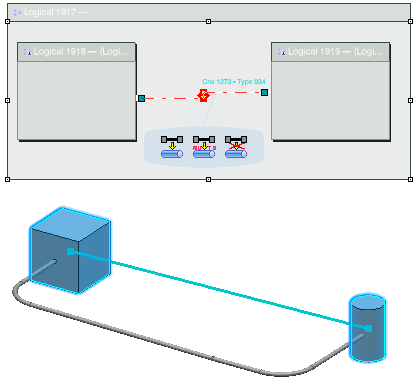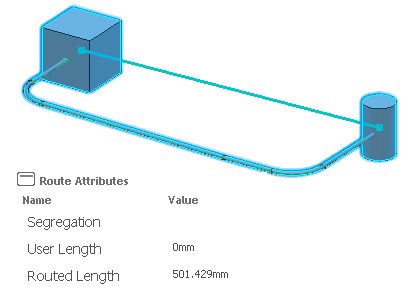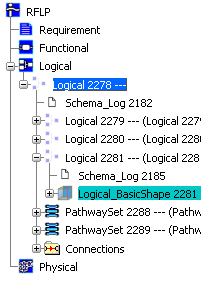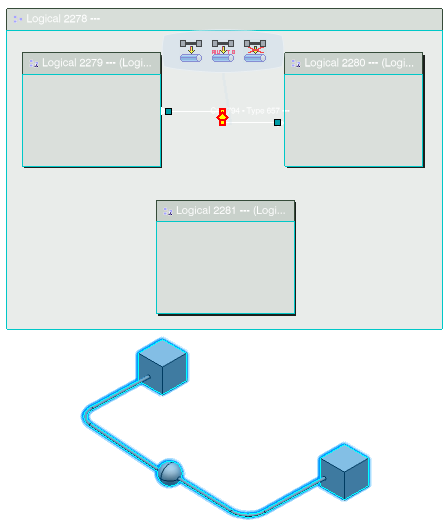Route Through a Pathway
This section describes how to route a logical connection or other routable object (logical net, net group, logical wire, cable, etc.) through a pathway.
In the 2D view, select the logical connection or logical object you want to route.
In the 2D view, a balloon appears. In the 3D view:
- The shapes at the ends of the logical connection are highlighted.
- A line representing the logical connection between the shapes appears.

In the balloon, click Manual Route  and then select the pathway or pathway segments through which you want to route the connection. and then select the pathway or pathway segments through which you want to route the connection.
In the 3D view:
- The segments are highlighted.
- The Route Attributes dialog box is displayed and shows the computed length of the route in the pathway segments you have selected.

Optional: Enter values for Segregation and User Length .
Click anywhere in 3D space when done.
The pathway segments are associated with the logical connection and the logical connection is considered to be routed.


Route Through a Logical Shape
This section describes how to define a logical shape as a component through which logical connections and other routable components can be routed.
You will use the Manual Route  command combined with the LSR_ValidateRouteComponent business rule. command combined with the LSR_ValidateRouteComponent business rule.
Ensure that the LSR_ValidateRouteComponent business rule is correctly configured and placed in the appropriate directory (see Related Topics). To define a logical shape as a route component: - In the RFLP tree, right-click the logical shape you want to use as a route component and select Properties.

- In the Properties dialog box, under the Representation Reference tab, enter RouteComponent in the Description box.
- When finished, click OK.
The dialog box closes.
The logical shape can now be used in conjunction with pathways to route logical connections and other routable components. In the 2D view, select a logical connection. In the 2D view, a balloon appears.
Click Manual Route  and in the 3D view, select the pathway segments and the logical shape (in this example the logical shape is the sphere). and in the 3D view, select the pathway segments and the logical shape (in this example the logical shape is the sphere).
Although the logical shape is not a pathway segment, you can select it and use it as such because of the steps you have taken earlier:
- You defined the logical shape as a route component.
- You configured the LSR_ValidateRouteComponent business rule correctly and placed it in the appropriate directory.

Click anywhere in the 3D area to validate. In the 2D view, select the logical connection to see the cross-highlight in the 3D view.

In the image above, you can see that the logical 3D Representation is highlighted as part of the route (and is therefore a route component). Optional:
Once the component is selected, set the routed length using the LSR GetLengthOfRouteComponent business rule.
The LSR GetLengthOfRouteComponent business rule
allows you to define the routed length of a component which has previously been assigned as a route component using the LSR_ValidateRouteComponent business rule.
|